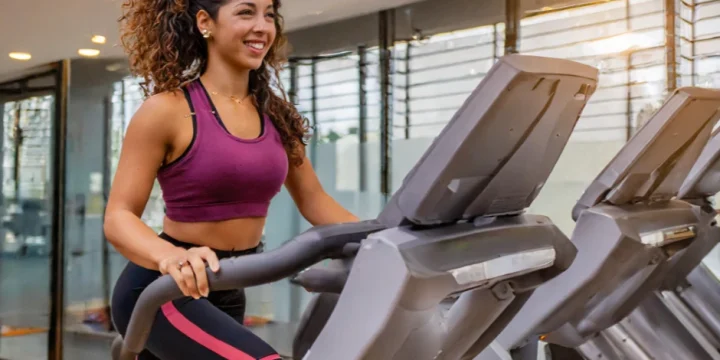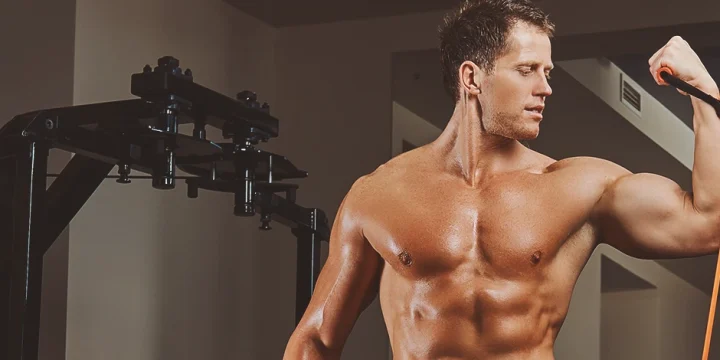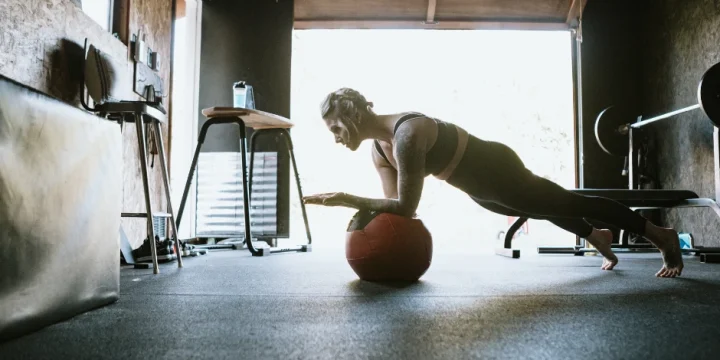Bulking can be challenging since many things about the number of carbs, protein, and type of workout you need must be clarified.
To bulk effectively, I've learned that it's crucial to nail down your bulking workout, dial in your nutrition, and make smart use of supplements.
Based on my weeks-long research and consultation with other fitness experts, I compiled the best bulking workout plan, dieting examples, tips, and more.
Quick Summary
- The bulking workout plan includes a six-day split where you must hit each major muscle group twice.
- To get the most out of your workout, you must get a training partner, use proper hydration, keep a workout log, and switch up your activities.
- According to a study in the MDPI Journal, the submaximal effort strength training method is proven to promote muscle growth effectively.
- In my experience, consistent effort and a balanced diet are key to successfully gaining size in the thighs and hips.
Bulking Workout Routine

To ensure maximal muscle growth and weight gain, you must use specific training methods to support anabolic effects post-workout.
There is only one strength training method to gain muscle and lose body fat - strength training for submaximal efforts.
It requires training with submaximal resistance on almost every exercise, but never until failure.
A study in the MDPI Journal has proven that the only way to gain muscle, lose body fat, and boost hypertrophy effects through strength training is to make submaximal efforts without failure [1].
Here is the workout plan you must follow to avoid fat gain and maximize building muscle.
"Gaining muscle, known as muscular hypertrophy, requires some serious strength training. Strength training causes microscopic tears in the muscle fibers, which sounds scary but is actually a prerequisite of growth."
- Spencer Cartright, Certified Personal Trainer
Also Read: Slim Thick Workout Plan
Day 1 - Chest, Shoulders, and Triceps I
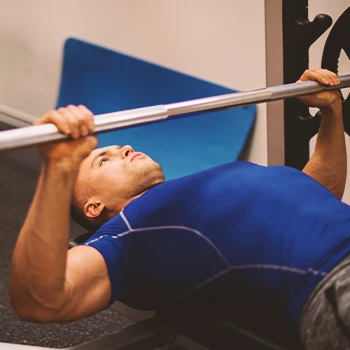
The first day mostly follows vertical and horizontal push movement patterns and focuses on elbow extension later in the workout.
The workout of Day 1:
- Bench press - traditional bench press performed with a standard barbell. The number of sets to complete is 4 with eight reps and 90 seconds rest interval.
- Incline Bench press - regular incline press performed bilaterally with two dumbbells. The number of sets is 4, 8 repetitions, and 90 seconds rest interval in-between.
- Push-up - after the first two exercises, you should have little energy left to complete weighted push-ups. That's why you should do bodyweight push-ups for three sets, ten reps, and 60 seconds rest in between.
- Dumbbell overhead press - a pair of appropriate dumbbells perform it. The number of sets is 4, 8 repetitions, and 90 seconds rest interval in-between.
- Dumbbell lateral raise - lateral raises are performed with lighter weights and two dumbbells in total. You should perform three sets of 10 reps and rest for 60 seconds between the sets.
- Triceps pushdown - you may perform the tricep pushdown using different alternatives, such as an elastic band, free weight, rope, or other cable attachment. The number of sets is 3, 10 repetitions, and rest for 60 seconds between the sets.
- Dumbbell kickback - performed with one hand, unilaterally, with only one dumbbell of small size. The number of sets is 3, 10 repetitions, and the rest between the sets is 60 seconds.
- Hanging leg raise - exercise performed on the pull-up bar with your body weight. Perform 12 repetitions for three sets and rest for as little as possible in between the sets.
- Decline bench reverse curl-up - the equipment you will need is an adjustable bench. The number of sets is 3, 12 repetitions, and the rest as little as possible.
- Flutter kicks - these exercises don't require any equipment. It is performed for three sets for 30 reps and 30 seconds rest interval.
Day 2 - Back and Biceps I
The main focus on this day is to hit back muscles through vertical and horizontal pull movement patterns. Elbow flexion is focused more at the end of the workout.
The workout of Day 2:
- Pull-up - the only equipment you will need is a pull-up bar. The number of sets to perform is 4, 8 repetitions, and up to 90 seconds rest interval between the sets.
- Bentover row - you need a regular or Olympic barbell to perform bent-over rows. Perform four sets for eight repetitions and rest for 90 seconds in between the sets.
- Lat pulldown - the equipment you will need is a lat pulldown or cable machine. Perform four sets for eight reps and rest for 90 seconds between the sets.
- Seated cable row - perform the exercise on the lat pulldown bar. Complete eight reps for four sets and 90 seconds rest intervals.
- Shrug - you need a barbell or a pair of dumbbells/kettlebells. Perform three sets of 10 repetitions and 60 seconds rest interval between the sets.
- Biceps curl - biceps curls can be done with an elastic band, dumbbells, kettlebells, or a cable machine. Complete three sets of 10 reps and rest for no more than 60 seconds.
- Hammer curl - hammer curls should be performed with dumbbells or kettlebells. The number of sets is 3, 10 repetitions, and a rest interval of 60 seconds.
Read More: 2 Best Back and Biceps Workout
Day 3 - Legs I
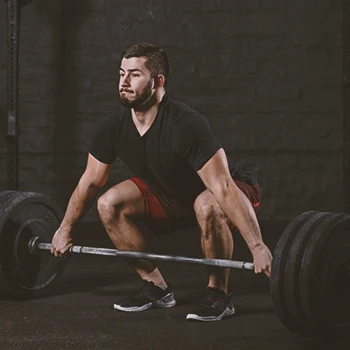
The third day focuses on hitting your legs through hip hinges and knee-bent movement patterns. Exercises for the smaller muscle groups and core are tackled later in the workout.
The workout of Day 3:
- Squat - the equipment you need is a squat rack. The number of sets to be performed is 4, 8 repetitions, and a rest interval of 90 seconds.
- Deadlift - you will need a standard or Olympic barbell. Perform up to 4 sets of 8 reps and rest no more than 90 seconds in between.
- Dumbbell lunge - you can perform it with a pair of appropriate dumbbells. The number of sets is 4, 8 reps, and the rest interval is 90 seconds.
- Barbell glute bridge - glute bridges can be performed with barbells or sandbags. Perform eight reps for four sets and rest for 90 seconds.
- Standing calf raise - standing calf raises are performed on a plyo box or a flat bench. The number of sets you must perform is 3, 10 repetitions, and the rest interval is 60 seconds.
- Seated calf raise - seated calf raises are performed on the box/bench with a pair of dumbbells. The number of repetitions is 10 for three sets, and the rest interval is no more than 60 seconds.
- Horizontal cable woodchop - you can perform this exercise with a cable machine. The number of sets is three, 15 repetitions, and the rest is as small as possible between the sets.
- Side plank with lateral raise - side plank with a lateral raise is performed with small dumbbells with no more than 4 kg. Perform 15 reps for each side for three sets, with as little rest as possible.
- Barbell hip thrust - get a barbell and a flat bench/plyo box to perform a hip thrust. The number of sets is 3, 15 repetitions, and the rest interval is 30 seconds.
Day 4 - Chest, Shoulders, and Triceps II
The focus of Day 4 is shoulders, chest, and triceps, but with a little different set of exercises compared to Day 1.
The workout of Day 4:
- Band-resisted flye - these flyes should be performed with appropriate difficulty resistance bands. Perform four sets for 12 reps and rest for 30 seconds between the sets.
- Dumbbell flye - this exercise requires a pair of regular dumbbells. Perform 12 reps for four sets and rest for no more than 30 seconds between the sets.
- Cable crossover - the necessary equipment is a cable machine. The number of sets is 4, 12 reps, and the rest is at most 30 seconds.
- Dumbbell squat front raise - you will need a pair of dumbbells for this exercise. The number of sets is 4, 12 reps, and the rest interval of 30 seconds.
- Dumbbell overhead press - pick a pair of appropriate size dumbbells. Perform 15 reps for three sets and rest for 30 seconds.
- Incline dumbbell skull crusher - the necessary equipment is a flat bench and a single dumbbell. Perform 15 reps for three sets and rest for 30 seconds.
- Bench dip - you need a flat bench to perform this exercise. The number of reps is 15, 3 sets, and a rest interval of 30 seconds.
Day 5 - Back and Biceps II
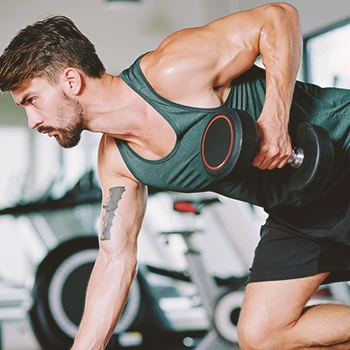
Day 5 focuses on back muscles but with a slightly different set of exercises. At the end of the workout, single-joint elbow flexion exercises are performed to target getting bigger biceps.
The workout of Day 5:
- Chin-up - you will need a pull-up bar. Perform four sets for 12 reps and rest for 30 seconds.
- One-arm dumbbell row - pick a single dumbbell of the appropriate weight. Perform 12 reps for four sets and rest for at least 30 seconds.
- Lat pulldown - you must have access to a cable machine. The number of sets is 4, 12 repetitions, and the rest is no more than 30 seconds.
- Dumbbell row - pick a pair of appropriately sized dumbbells. The number of repetitions is 12, 4 sets, and the rest is no more than 30 seconds.
- Shrug - pick two dumbbells or load a barbell. Perform 12 reps for four sets, and the rest interval should be no more than 30 seconds.
- Cable rope curl - the necessary equipment is a cable machine. Perform 15 repetitions for three sets and rest for 30 seconds.
- Cable crossover curl - you need access to an adjustable cable machine. Perform three sets of 15 reps and rest for 30 seconds.
- Neutral-grip triceps extension - pick a pair of dumbbells. Perform 12 reps for three sets and rest for as little as possible.
- Weighted Swiss ball crunch - the equipment you need is a Swiss ball. Perform 12 reps for three sets and rest for as little as possible.
- Crunch - done on the ground or the Swiss ball. Perform three sets of 12 reps and rest for 30 seconds in between.
Day 6 - Legs II
Day 6 is the last day of the week for workouts, and the leg exercises have changed slightly, but the movement patterns stay the same. Also, there are some changes in the intensity and overall volume.
The workout of Day 6:
- Dumbbell squat - you can perform this exercise with one or two dumbbells. The number of sets is 4, 15 repetitions, and the rest interval is 30 seconds.
- Dumbbell lying hamstring curl - you need access to a flat bench. Perform four sets of 15 reps and rest for 30 seconds between the sets.
- Squat - you need a barbell and a squat rack. Perform up to 14 reps for four sets and rest no more than 30 seconds.
- Single-leg calf raises - these can be performed with a kettlebell or with your body weight. Perform up to 3 sets of 13 reps and rest for as little in between as possible.
- Standing calf raise - necessary equipment includes a box or a flat bench. The number of sets is 3, 12 repetitions, and the rest is no more than 30 seconds.
"Once you complete a set of an exercise, you’ll rest, then repeat for the prescribed number of sets that follow. This is another strategy to allow for ample recovery. The only time “tri-sets” will be used are for short ab/core workouts at the end."
- Tim McComsey, Certified Personal Trainer
Also Read: Seth Feroce Leg Workout
Workout Tips

Here are some workout tips to remember to increase your muscle mass and decrease body fat percentage.
Get a Training Partner
You can’t work on your strength and increase your hypertrophy if you don’t have somebody to look out for you during those sets of submaximal effort.
Performing multiple sets of heavy bench presses or any other compound exercises can increase the chance of injury.
A training partner is there to help you push more weight, feel more secure, avoid injuries, and increase muscle hypertrophy by motivating you to do more.
Sip Water During Workouts
You must always bring enough water, or at least have access to water, whenever you lift heavy or do any form of intense cardiovascular exercise or resistance training sessions.
Occasional water sips during a workout can help your hydration and make you more focused, and even increase your lifting performance.
Having less water than necessary can cause brain fog, increased chance of injury, and lack of concentration.
Use the Mirrors

Using mirrors to check your form occasionally can significantly change it.
However, never check your form during heavy lifting if it makes you twist your head in any direction deviating from the one that technique suggests.
Breaking your kinetic chain can cause severe injuries, and you must avoid that.
I suggest you perform bodyweight exercises or light weights when checking your form.
That is the only way when you can look away to check it since a lighter load won’t cause any injuries.
Keep a Workout Log
Since you must always use the principle of progressive overload to make changes and necessary adaptations to your strength, logging everything is essential, according to a study in the National Library of Medicine [2].
The training method mentioned above requires you to always stay above 80% of your 1RM (repetition max).
Since your 1RM will increase due to the super-compensation of glycogen and muscle hypertrophy, constantly monitoring it is a must.
There is no other way to know what percentage of 1RM to use to work the next workout if you don’t log everything.
Related: Best Hypertrophy Program
Switch up Your Workouts

I found it's best to constantly change how you train to experience muscle gain through weight training.
During my college years, when I studied sports science, a professor majoring in strength made something very clear to use.
“Strength loves diversity.”
This means you shouldn’t change the philosophy behind your programming regarding muscle groups, movement patterns, and sport-specific exercises.
However, you must change the angle of the exercise, equipment, tempo, load, method, and similar.
Rest and Recovery
Here's why rest and recovery are crucial and how to incorporate them effectively:
- Importance of sleep: Adequate sleep is when your body primarily focuses on repairing and growing muscles. During deep sleep, growth hormone levels peak, and muscle tissue regeneration occurs. Aim for 7-9 hours of quality sleep per night to optimize muscle recovery.
- Active recovery: Incorporate light activities like walking, yoga, or swimming on your rest days. Active recovery promotes blood circulation, reduces muscle soreness, and can accelerate the healing process, allowing you to get back to intense workouts more quickly.
- Rest days: They help prevent overtraining, reduce the risk of injuries, and allow your muscles and central nervous system to fully recover. Typically, one or two rest days per week are recommended.
- Foam rolling and stretching: Self-myofascial release techniques, like foam rolling, can alleviate muscle tightness and improve flexibility. Incorporate stretching exercises to enhance range of motion, reduce the risk of muscle imbalances, and prevent injuries.
- Listen to your body: Pay attention to signs of overtraining, such as persistent fatigue, decreased performance, and chronic soreness. Adjust your training intensity or take extra rest days if needed. Remember that muscle growth occurs during recovery, not just during workouts.
The Bulking Diet
Here is a sample meal plan you can follow during the bulking phase.
- Breakfast: We want to include food such as egg whites, turkey, and milk for breakfast.
- Mid-Morning Meal: We should have a sandwich with roast beef and a glass of milk for the mid-morning meal.
- Lunch: We will have a regular portion of chicken breasts and milk for lunch.
- Mid-Afternoon Meal: You can eat one protein bar and take a protein shake for the mid-afternoon meal.
- Pre-workout Meal: Take a glass of milk and a protein shake for the pre-workout meal.
- Dinner: Combine steak, asparagus, brown rice, and a full glass of milk for dinner.
"Clean bulks are generally slower and the goal is to minimize fat gain as you build muscle. With clean bulks, you prioritize healthy bulking foods and just enough of a calorie surplus to add some muscle."
- Garret Reid, Certified Strength & Conditioning Specialist
Nutritional Timing
Nutritional timing is a crucial aspect of any successful bulking strategy. When you consume nutrients can significantly impact your muscle growth and overall progress. Here are key points to consider:
- Pre-workout nutrition: Before hitting the gym, it's essential to fuel your body properly. A balanced meal or snack containing carbohydrates and protein about 1-2 hours before your workout can provide the energy and amino acids needed for an effective training session.
- Post-workout nutrition: Immediately after your workout, your muscles are primed for nutrient absorption. This is the perfect time to have a post-workout meal or shake rich in protein and fast-digesting carbohydrates like dextrose. Protein helps repair and build muscle tissue, while carbohydrates replenish glycogen stores, promoting recovery.
- Intra-workout nutrition: Some individuals benefit from intra-workout nutrition, especially during intense and prolonged training sessions. Consuming branched-chain amino acids (BCAAs) or a specially formulated workout drink can help prevent muscle breakdown and maintain energy levels during extended workouts.
The Bulking Supplementation

Here are all supplements you need for gaining weight and to support your bulking process.
Protein Shakes
According to a PubMed study, proteins are essential for faster muscle recovery and increasing muscle mass [3].
My clients found these two main protein types the most beneficial: whey and casein.
Casein absorbs slower but remains more in your bloodstream, while whey protein enters your bloodstream faster but also exits earlier.
I suggest taking a whey protein shake after every lifting session.
Also check our guide on the 10 best protein powders for men in 2023 to pick the best one that suits your needs.
Multivitamins
Multivitamins can help you recover faster and improve your performance [4].
However, I found I shouldn't bother as much with multivitamins if I set my set correctly.
This is because most of the vitamins you can acquire through proper diet and adequate food sources.
Creatine

You must supplement with creatine since it supports the fastest energy source of your body, the creatine-phosphate.
Creatine-phosphate synthesizes adenosine-triphosphate, the energy currency of our body, the fastest and is used for high-intensity activities.
Creatine is proven to increase sports performance in high-intensity activities such as sprinting, lifting heavy weights, or performing maximal jumps [5].
Ready to Drink (Rtd) Shakes
My clients say that Ready to Drink (Rtd) Shakes can also benefit their faster recovery and improved performance for the following workout session.
The most important thing to look for on the label is the amount of protein and carbohydrates the shake contains.
Ready-to-drink shakes should only come into consideration if you fail to prepare your regular protein/carb/creatine post-workout shakes.
Nitric Oxide (NO)
Nitric oxide has been proven to improve cardiac health and enhance exercise performance [6].
This is especially true for cardio exercises since nitric oxide improves the function and efficacy of your mitochondria.
These are small parts of your cells responsible for respiratory functions on the level of a cell.
FAQs
Which Workout Is Best for Bulking?
The best workout for bulking is the one using submaximal loads without going to failure. This has been scientifically proven to support anabolic processes post-workout and increase muscle hypertrophy.
Can You Do a 4 Week Bulk?
Yes, you can do a 4 week bulk. You should expect to spend at least 4 to 6 weeks for any bulking or cutting cycle.
How Can a Skinny Guy Bulk Fast?
A skinny guy can bulk fast by lifting weight regularly, eating many calories, implementing rest and recovery principles, and eating nutrient-dense foods.
References:
- https://www.mdpi.com/2075-4663/7/7/169
- https://www.ncbi.nlm.nih.gov/pmc/articles/PMC4215195/
- https://pubmed.ncbi.nlm.nih.gov/24435468/
- https://pubmed.ncbi.nlm.nih.gov/22330823/
- https://www.ncbi.nlm.nih.gov/pmc/articles/PMC8228369/
- https://www.ncbi.nlm.nih.gov/pmc/articles/PMC3184682/
About The Author
You May Also Like
